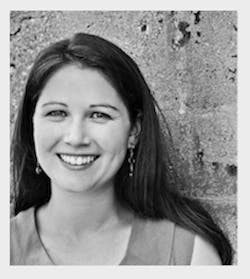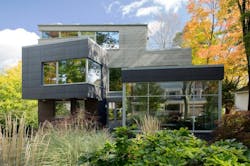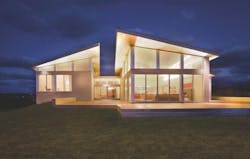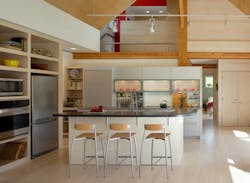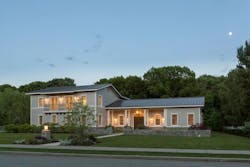Q + A: Designing a Sustainable Future
Stephanie Horowitz is managing director of the Boston-based architecture and energy consulting firm ZeroEnergy Design. The firm brings green and high-performance design to new and old construction projects throughout the U.S., winning its fair share of awards in the process, including Boston Magazine’s Best Sustainable Architect award in 2020. Horowitz also currently serves as president of Passive House Massachusetts. She took time out of her busy schedule to chat with Custom Builder about green building.
How did you begin your journey with green and sustainable building design?
My interest in architecture and design really developed with my interest in energy and environment. The two have always been intricately linked for me, and it was something that was a focus of my studies as a young professional right out of the gate. I was really committed to practicing architecture with an awareness and appreciation for the relationship between buildings and the environment.
Was that one of your personal values or was it a discovery through your education?
I think it was a value of mine and was an appreciation and understanding I had even before entering architecture school—that buildings have an impact on energy, on the environment, on occupants’ health, and that the only way we should be practicing architecture is by acknowledging and understanding that relationship.
How has green building/net zero design changed since you first began?
I think it’s gone from being fringe to becoming more mainstream. There have been increases in the availability of information, products, and construction expertise. There’s definitely been a notable transformation in the market, and in consumers, over the past 15 years or so.
Is there one area in particular you think builders and designers should focus on if they want to dip a toe into green building design?
I would probably say they should start with looking at the construction and detailing of the building enclosure. For designers, it really does begin with design, not the technical aspects.
If you’re looking to bridge designers and contractors, I would start with understanding the building enclosure and how one might improve upon standard practice to address energy use, durability of the enclosure, and occupant health and comfort.
What that improvement to the enclosure is really depends on the climate zone. The things that are important in a cold climate—in which I practice—are going to be things that may be more or less important for another practitioner who is working in a desert environment, for example. Understanding the climate-specific details to improve the building enclosure is a great place to start.
Some builders and designers are hesitant to embrace green principles for a variety of reasons, such as cost and difficulty
Do you think these common hesitations hold weight or are they just misconceptions?
It probably depends on what we’re talking about. There’s definitely low-hanging fruit—things that can be done at low cost or at a cost comparable to conventional construction, such as detailing an air barrier, for example, in the building enclosure. And it requires doing some things differently, making some additional callouts and provisions, but it can be done using conventional materials that are already part of any building enclosure.
There are other elements that can add cost, but there are also elements that shift cost. For example, one thing that’s standard practice in our cold climate is to incorporate continuous insulation in the building enclosure. That’s something that, compared with conventional construction, does add cost to the building enclosure. You’re adding a layer of insulation—and the associated labor. However, adding that insulation to improve the performance of our building enclosure also allows us, with other measures, to decrease the size of the mechanical system.
So, while we may be increasing the cost of the building enclosure, we’re decreasing the cost of the mechanical system. It’s important to make sure you’re looking at these changes holistically within a project budget because there are opportunities to shift cost in very beneficial ways.
What is the future of green building design?
I see the trend continuing; that these practices are becoming more and more mainstream and quantified ... that this is going to be a requirement going forward—that we need to design and build our homes and buildings to this higher standard.
The renovation work can be a bit challenging. New construction is really the opportunity to capitalize on building projects that are going to be around, hopefully, for the next 60 to 100 years. It’s important we get these details right to help ensure these structures are going to support us going forward when it comes to energy, health, comfort ... even embodied energy.
I think the building codes have been slowly stepping in the right direction in terms of requiring these minimum standards and that will continue to propel the bell curve. We’re seeing more towns take the initiative to raise the bar higher than required by code for projects that need zoning board approval or have some sort of local permitting component.
Your firm has an impressive portfolio. Do you think your focus on eco-friendly practices is a draw for clients?
I think the draw is the pairing of our expertise in energy, environment, and health with a great design practice. We’re not just doing the energy and environmental stuff in making new buildings; we’re pushing forward the beauty and the brains, if you will. That pairing is, I think, what really resonates with clients.
What advice would you give to aspiring green builders and designers?
Seek out the expertise you need to improve and evolve your practice. Whether it’s the myriad professional resources available online or the amazing regional conferences on these subjects. Thinking back to 15 years ago, there’s really a wealth of high-quality information available now for those who choose to engage, and from there, it’s fine to find a peer or a mentor to assist you in [overcoming] any stumbling blocks you encounter to start changing and evolving the way you practice one step at a time.
